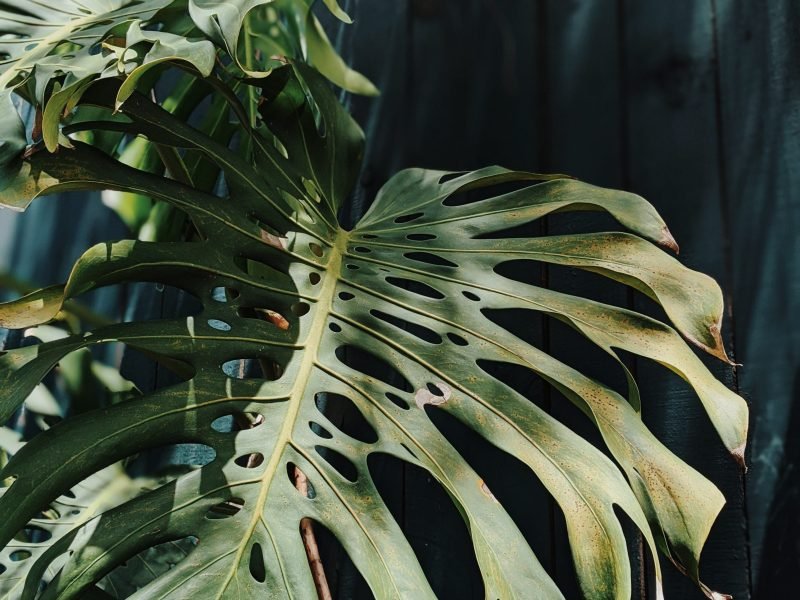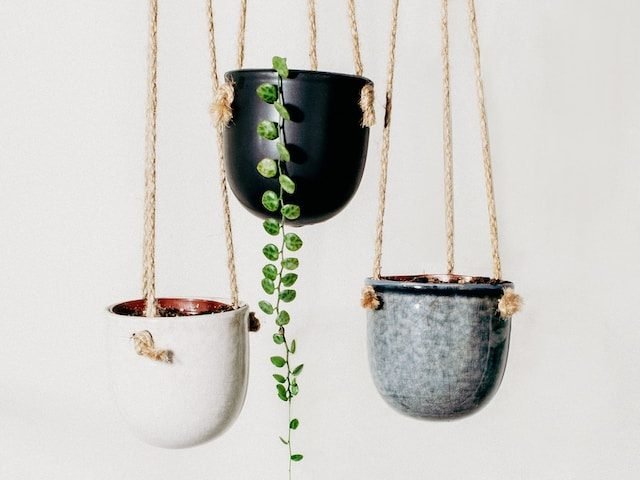Burnt monstera leaves

Monstera plants have become increasingly popular among plant enthusiasts due to their unique heart-shaped split leaves. However, as with any plant type, your Monstera is still susceptible to a wide range of issues if there are problems with either the care or any environmental factor.
One issue you can find with Monsteras is burnt leaves, which can be very frustrating. This can appear as yellow patches or spots across the plant, or concentrated on the leaf tips. Luckily though there are only really two main causes of burnt leaves on a Monstera, which makes diagnosing and fixing the issue a lot easier than with other common problems.
In this article, we will discuss not only the two common causes of burnt Monstera leaves but also how to treat and prevent the issue.
Common Causes of Burnt Monstera Leaves
Too much direct sunlight
The most common reason why your Monstera has developed burnt patches or spots across its leaves is exposure to too much sunlight. This will only tend to happen during summer when the sun is a lot strong and is out for more of the day. During winter, you can place your Monstera closer to the window without fearing sunburn as the sun is weaker.
If your Monstera is receiving several hours of direct sun rays on its leaves, then this is likely the cause of the burnt and scorched leaves.
To diagnose the issue, monitor the environment around your Monstera throughout the day. It may be that it isn’t receiving any sunlight in the morning, but is hit with intense sun rays all afternoon without you realising it.
Over-fertilization
The other potential cause of burnt Monstera leaves is over-fertilization. This can either be happening because you are fertilizing your Monstera too deeply or too frequently. Fertilizing over autumn and winter can also cause burnt leaves as your plant is in its dormant phase and won’t be producing new growth.
Getting the right amount of fertilizer for your individual plant can be tough as there is no one-fits-all amount. Factors such as light level, pot size, plant size and age can all affect how much your Monstera needs to be fertilized. This makes feeding the right amount a real guessing game.
Symptoms of Burnt Monstera Leaves
Brown or yellow spots on leaves
If your Monstera has developed brown and yellow spots on the leaves, then this can be an indication that it is being burnt either by too much light or fertilizer. The good thing about small spots though is that you should have caught the issue early which makes fixing it a lot easier.
When it comes to small spots, we also don’t recommend removing the leaves from your Monstera as they are still very valuable in the photosynthesis process. It is only when the majority or all of the leaf has burnt that we would recommend removing it.
When the leaf is burnt through sunlight, you’ll find most of the damage on the leaves that are facing the window. This is because they will have had more exposure to the light. However, you will often see damage across the plant to some extent as the whole plant will have dried up a lot quicker in the heat.
Brown and yellow leaf tips
If your Monstera has developed burnt yellow or brown leaf tips, then this is often an over-fertilization problem. If the leaf tips are only dry and brown then this tends to be caused by watering or humidity problems but if there are yellow halos, then this can indicate over-fertilization.
Burnt leaf tips on your Monstera also indicate that you have caught the problem relatively early which is great. The sooner you spot and treat an issue, often the easier it is to solve and the quicker your Monstera will get back to full health.
It’s worth noting though that once the leaf tips have burnt, there is no reversing this.
Large yellow patches across your Monstera
If your Monstera has developed large yellow burnt patches across its leaves, then the issue has probably been going on for a while without you noticing. If the issue is progressing quite fast, then this often means that intense direct sunlight is the cause rather than over-fertilization. This is because fertilizer issues are quite slow to develop into large burnt patches.
Curling or wilting of leaves
If the leaves on your Monstera are curling or have wilted alongside yellow patches or spots, then this can also mean that the issue has started to progress quite far. These problems on their own can indicate a range of issues beyond lighting or fertilizer so it is something you would spot alongside yellow burnt patches.
If the leaves that are facing the window are curling up a lot more, then lighting is most likely the answer. Monstera plants can naturally curl their leaves up away from the light source to protect themselves so watch out for this to help you diagnose the problem.
Brittle or dry leaves
Burnt leaves can also feel very brittle and dry to touch. This tends to happen more with lighting issues as the heat from the sun can very quickly dry out the leaves.
Leaf drop
Once the issue has been going on for a while and has progressed quite far, it can happen that the burnt leaves naturally fall off your Monstera. This will happen once the leaf is dead and your plant is no longer able to use it to photosynthesise.
Although the worst affected leaves will naturally drop, we do recommend trimming off leaves that are mostly or completely burnt. This will redirect any energy that your Monstera was using to try to keep it alive, into new healthy growth.
Solutions for Burnt Monstera Leaves
Now that you’ve hopefully been able to successfully diagnose why your Monstera has developed burnt leaves, the next stage is solving the issue. It’s important to make any changes as soon as you’re confident in the diagnosis as the longer the issue goes on, the more damage it’s causing. Over time, the issue will become increasingly more difficult to treat.
Adjust your Monstera’s positioning
The only way to prevent your Monstera from being burnt by the sun during summer is to find a more suitable spot for your plant. You want to find somewhere that still has ample sunlight but that light is indirect.
This means that none of the actual sun rays are hitting the leaves. Often this will be just a touch further in the room.
You will also need to think about the positioning throughout the year because it might be the case that your Monstera’s original placement was perfect in winter, but a little too bring in summer.
As the sun is a lot weaker in winter, you can and should be placing your plants a little closer to the windows to maximise on the light. A good light level in winter is crucial to avoid leggy, small growth but also risks caused by the potting mix not drying out as fast in darker areas. Because of this, you may just need to find a better spot for your Monstera in summer so that it’s not burnt by the sun but still has plenty of sunlight to aid new growth.
Flush out the soil
If you have used liquid fertilizer, then the best way to solve the issue is to flush out the soil. You can do this best by placing your Monstera in the shower and running water through it for a good few minutes. A lot of the excess fertilizer will flush out with the water through the drainage holes.
Replace the potting mix
If you have used fertilizer pellets that are mixed into the soil of your Monstera, then the only way to solve the issue is to replace the potting mix with fresh mix. If you have used fertilizer spikes, then it’s a little easier as all you need to do is remove those from the soil.
Prevention Tips for Burnt Monstera Leaves
Once you have taken the initial steps to solve the issue causing burnt leaves on your Monstera, you need to ensure that you are taking further action to prevent the issue from reoccurring. Below we’ve outlined a few tips…
Adjust fertilization schedule
If you have been over-fertilizing your Monstera and this is the cause of the burnt leaves, then one of the things you need to be doing is altering how often you are fertilizing your plant. This applies mostly when using liquid fertilizer as with the other types you will need to control how much you give (more on that below).
On average, you want to be fertilizing your Monstera no more than once a month during the growth period of spring and summer to avoid over-fertilization and burnt leaves. You should never be fertilizing during autumn and winter as your plant is dormant. Fertilizing during this time can be damaging to your plant and its root system.
There are, however, some factors which may mean you should be fertilizing your Monstera less than once a month. For example, if your Monstera is somewhere that doesn’t receive that much sunlight or if you’ve recently repotted your plant, then cut back fertilizer frequency to match this.
Dilute the fertilizer more
Alongside cutting back on how frequently you fertilize your Monstera, you can also treat burnt leaves by reducing how deeply you feed them. When fertilizing with a liquid fertilizer, all you need to do is dilute it more so that you aren’t adding as much feed in each time.
When fertilizing with spikes, you can either use less each time or break one in half if you are using a higher-strength fertilizer spike. Similarly with pellets that are mixed into the soil, add in less when you are next fertilizing. Research and understand the plant’s care requirements
Keep a close eye on your Monstera
We highly recommend that you give your Monstera a thorough check-up at least once a month if you aren’t already doing so. This will enable you to hopefully spot any early warning signs that something isn’t quite right before it is able to cause a lot of irreversible long-term damage.
Hopefully, this guide to burnt Monstera leaves and how to fix them has given you all of the information you need to diagnose, treat and prevent the problem. Too much sunlight and over-fertilization are your two main enemies when it comes to burnt leaves and because there are only two main causes, the diagnosis stage is a lot simpler. There are a lot of problems that have more than 8 potential causes which makes them a nightmare to properly figure out the cause.
Unfortunately, once you have treated the issue, the burnt patches on the leaves won’t turn back to their luscious green colour. You may then be wondering if you should be removing the burnt leaves from your plant but we only recommend you do this if the entire leaf (or most of it) is burnt. If there are only a few little patches, then this leaf is still very valuable to your plant. Removing too much can reduce how much your Monstera is able to photosynthesise, which can lead to smaller and more solid new leaves.
To learn more about how to care for your plant and diagnose/treat other common problems, check out our Monstera care guide.













